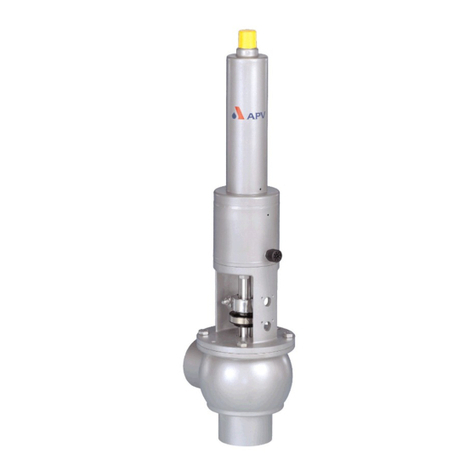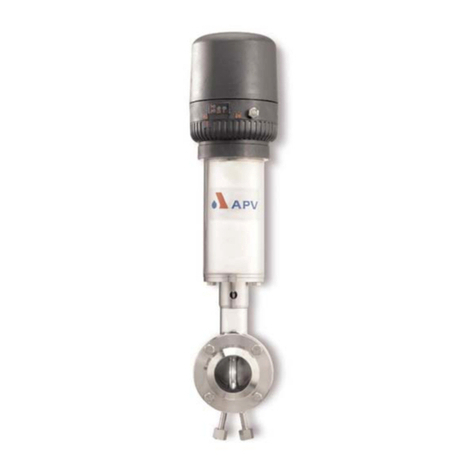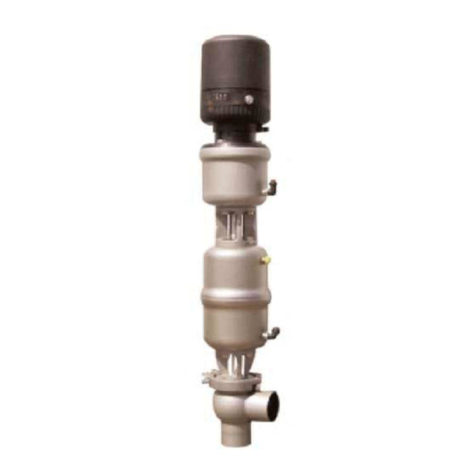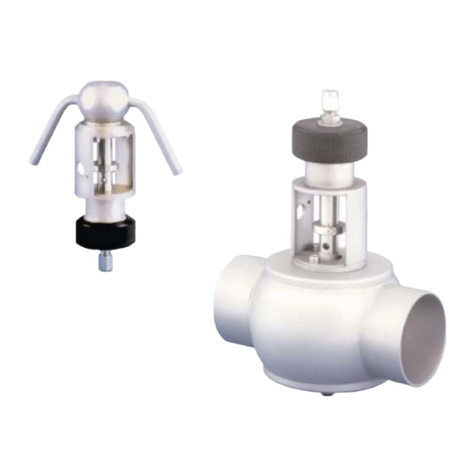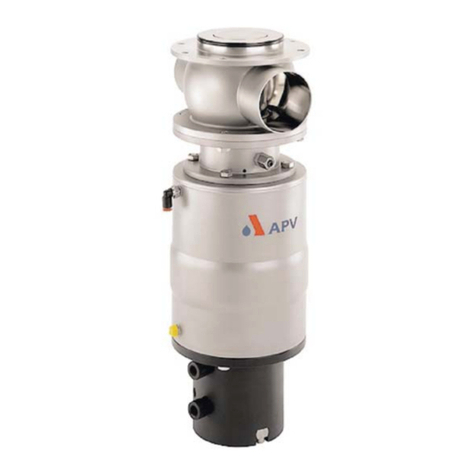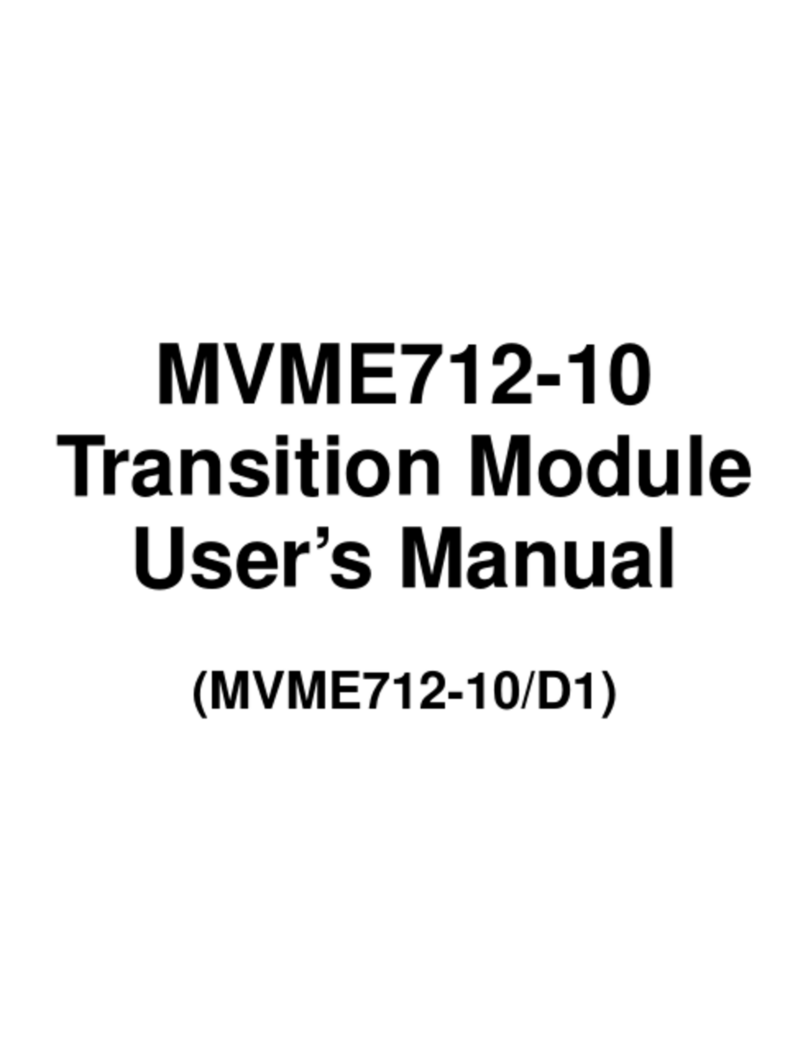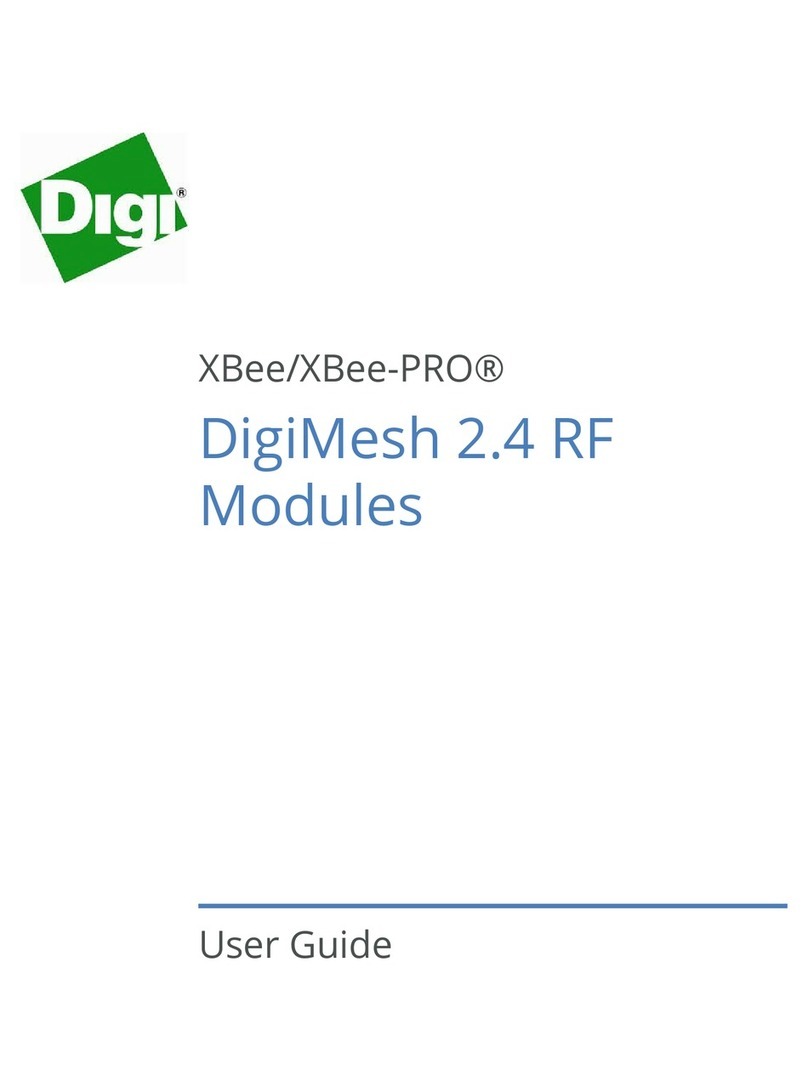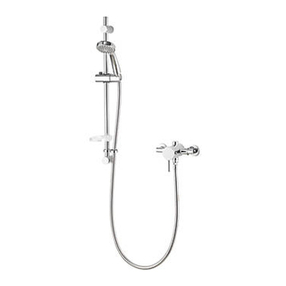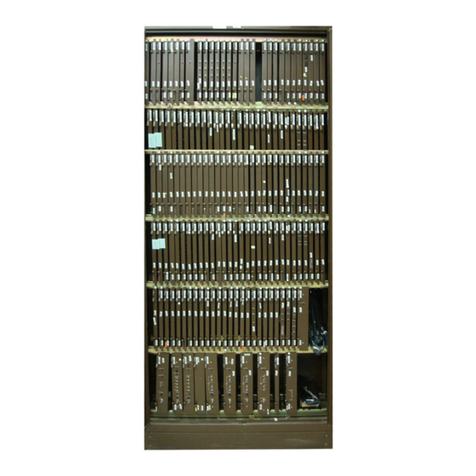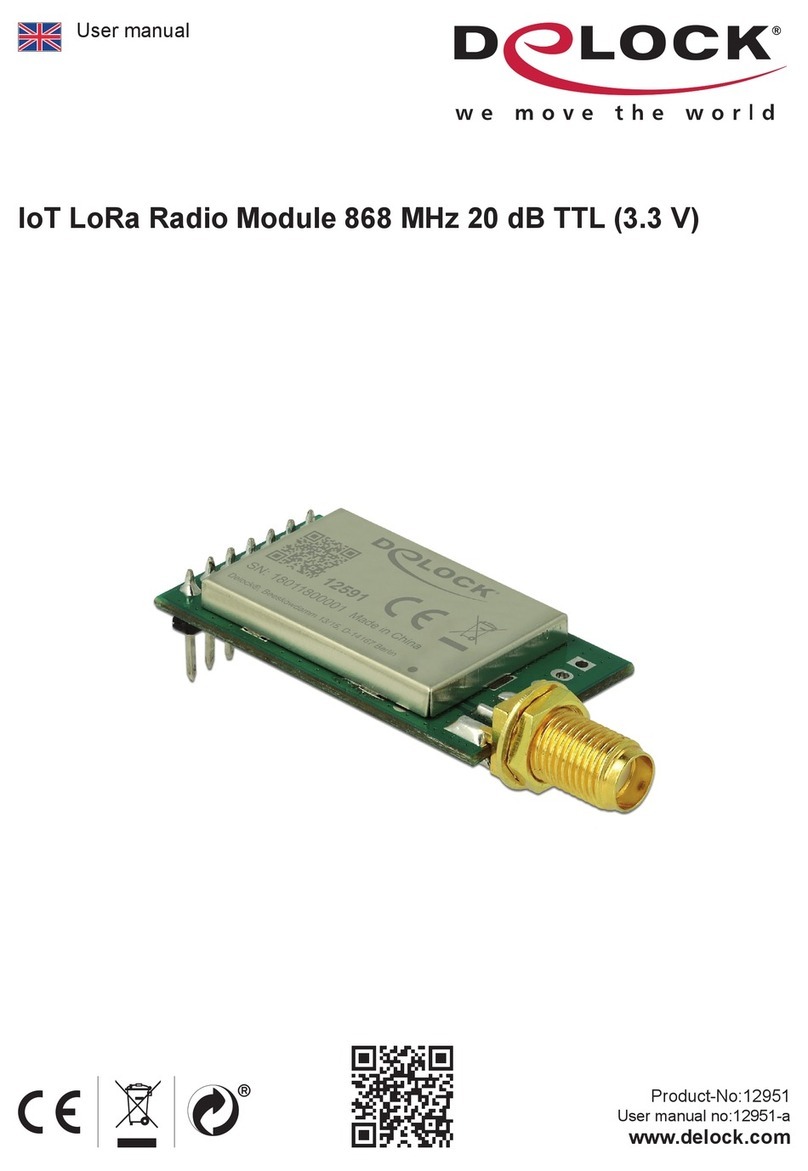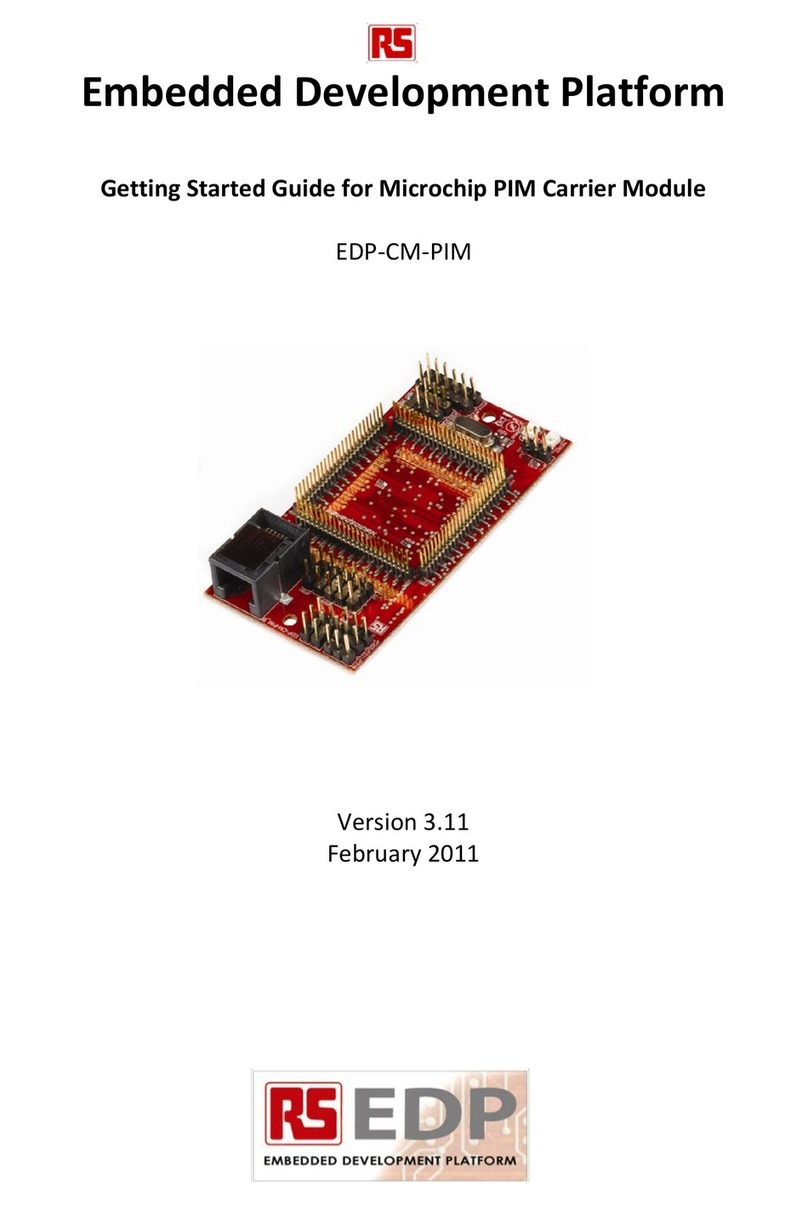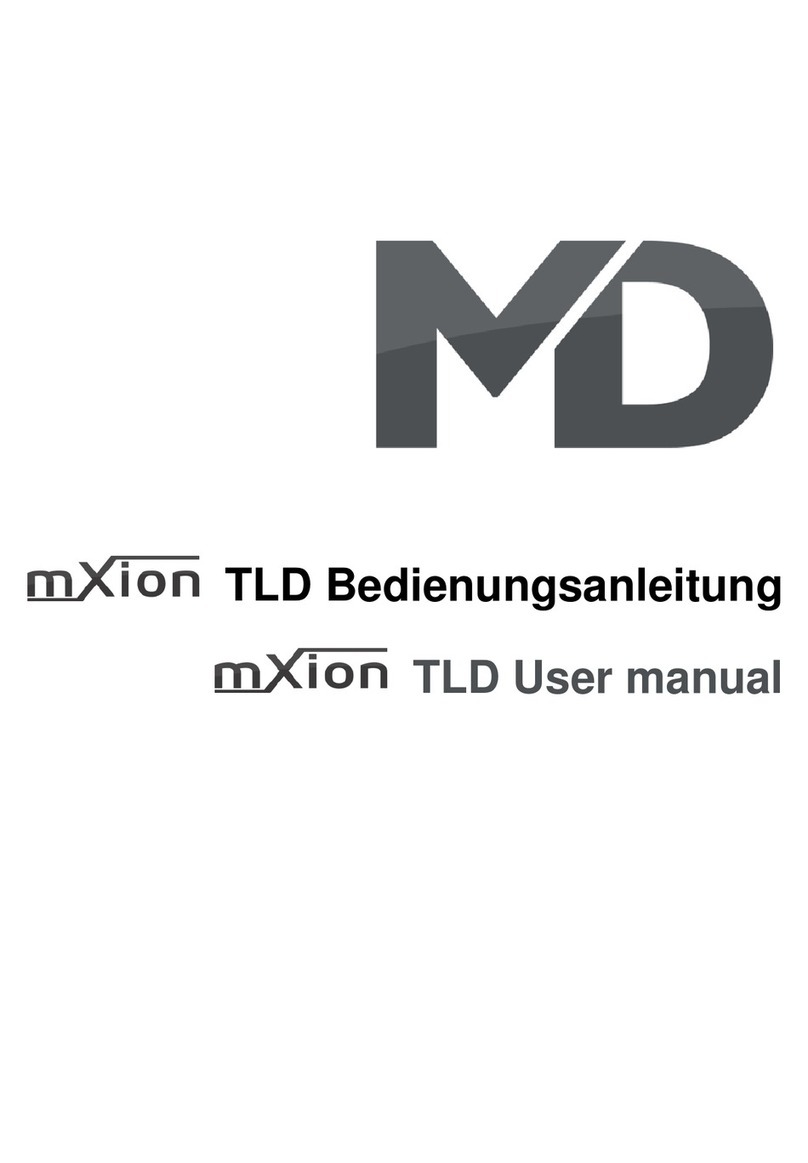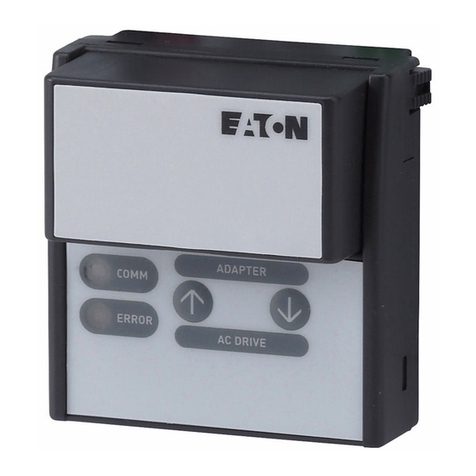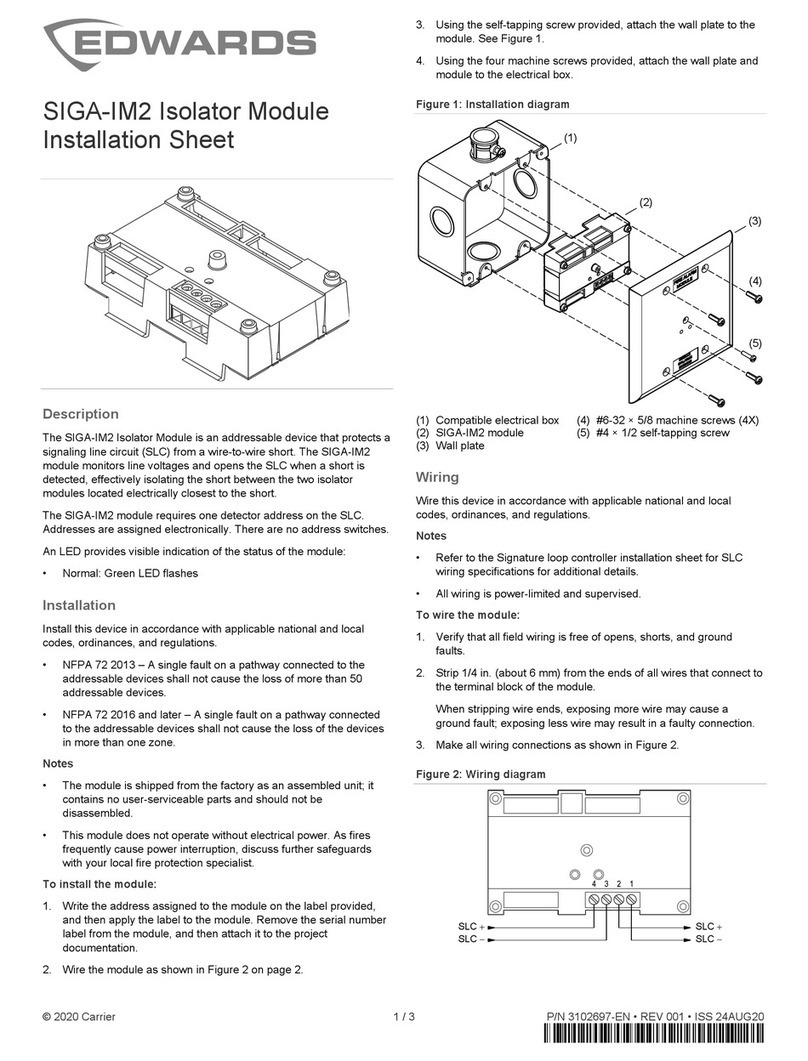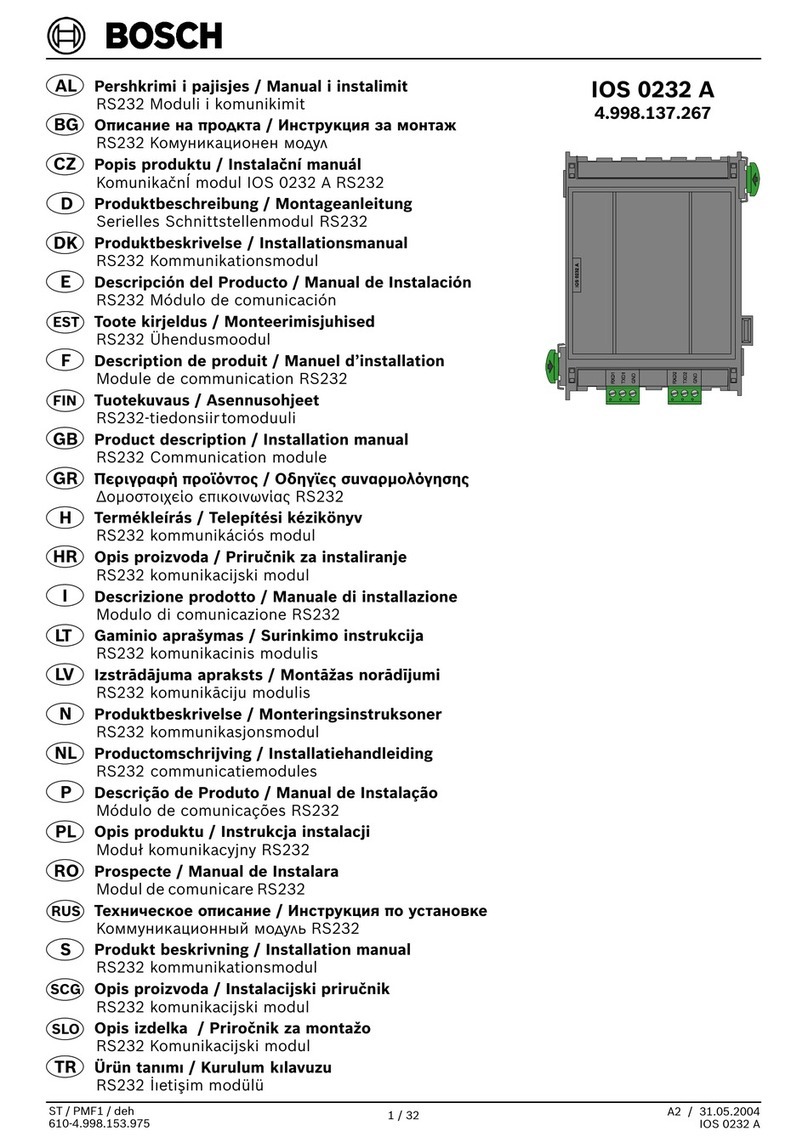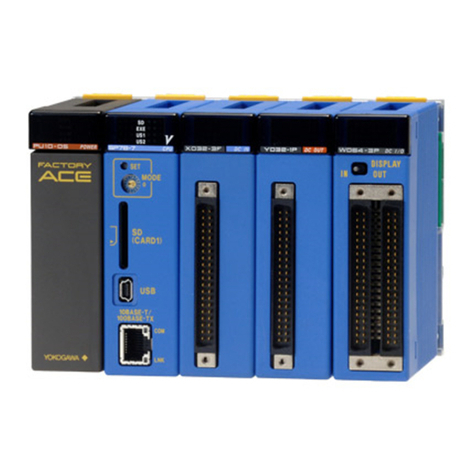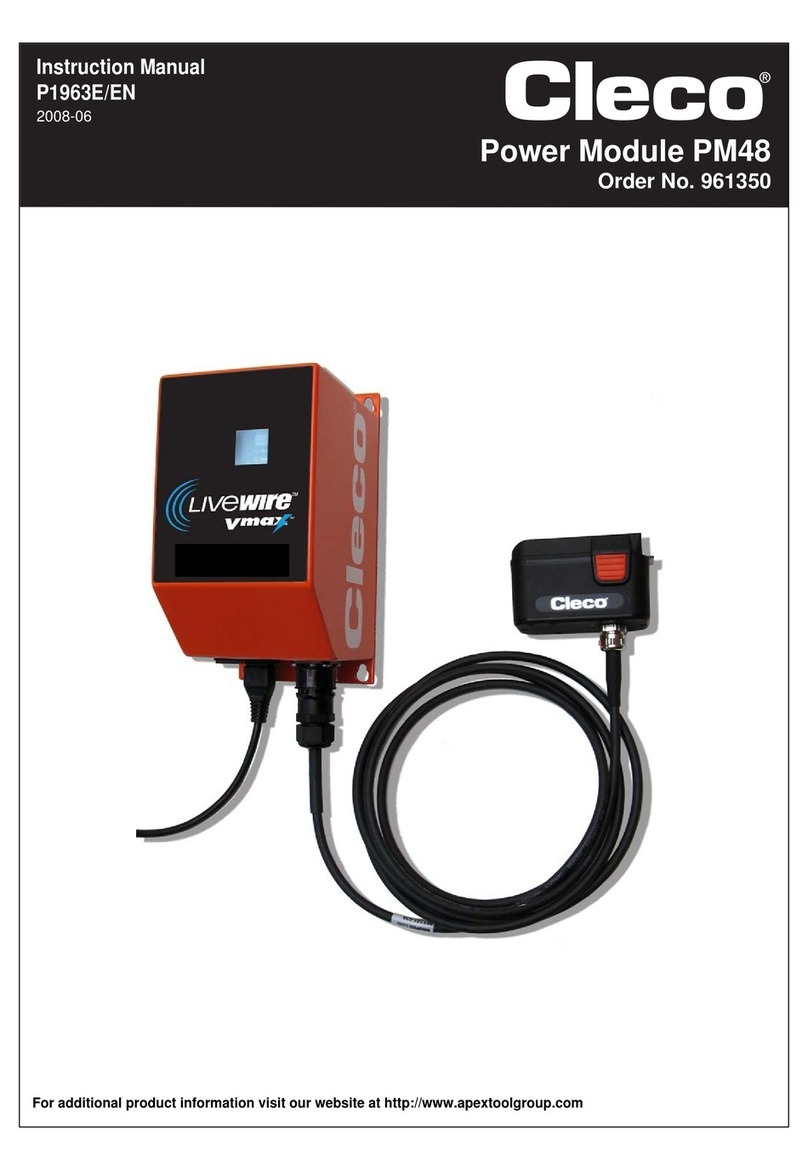SPX W Series User manual

W-Series Mix Proof Valves
W71, W72RS, W72RSP, W73 (IN O.D. TUBING SIZES)
FORM NO.: 95-03087 REVISION: 10/2012 READ AND UNDERSTAND THIS MANUAL PRIOR TO OPERATING OR SERVICING THIS PRODUCT.
INSTRUCTION MANUAL

Information contained in this manual is subject to change
without notice and does not represent a commitment on
the part of SPX Corporation. No part of this manual may be
reproduced or transmitted in any form or by any means,
electronic or mechanical, including photocopying and
recording, for any purpose, without the express written per-
mission of SPX Corporation.
Copyright © 2012 SPX Corporation
All Rights Reserved
Revision Date: 10/2012
Publication: 95-03087
SPX Flow Technology
611 Sugar Creek Road
Delavan, WI 53115 USA
Tel: (800) 252-5200 or (262) 728-1900
Fax: (800) 252-5012 or (262) 728-4904
E-mail: [email protected]
Web site: www.spxft.com
http://www.spx.com/en/assets/pdf/95-03087_w70mixproofv_wcb.pdf

10/2012 95-03087 Page 3
Waukesha Cherry-Burrell Table of Contents
Warranty ....................................................................................................................5
Shipping Damage or Loss ....................................................................................................... 5
Warranty Claim ........................................................................................................................ 5
Safety ........................................................................................................................6
Care of Stainless Steel ............................................................................................7
Stainless Steel Corrosion ........................................................................................................ 7
Elastomer Seal Replacement Following Passivation ............................................................... 7
Introduction ..............................................................................................................8
General Information ................................................................................................................. 8
Factory Inspection ................................................................................................................... 8
Models and Specifications ....................................................................................................... 8
Equipment Serial Number ....................................................................................................... 8
Operating Parameters ............................................................................................................. 9
Seal Compatibility ....................................................................................................... 9
Seat Options .......................................................................................................................... 10
Pressure Ratings ................................................................................................................... 10
Installation ..............................................................................................................11
Location ................................................................................................................................. 11
Welding Instructions ............................................................................................................. 11
Air Supply .............................................................................................................................. 11
Flow Direction ........................................................................................................................ 11
Fittings ................................................................................................................................... 12
Pipeline Support .................................................................................................................... 12
Installing Valve Manifolds ...................................................................................................... 12
Installing the Valve ................................................................................................................ 12
Quality of Control Air to Control Module ................................................................................ 13
External Flush - Liquid Vent Cavity ....................................................................................... 13
Liquid Vent Cavity Only ............................................................................................ 13
Liquid Vent Cavity and Lower Stem .......................................................................... 13
External Flush - Steam Vent Cavity ....................................................................................... 14
Steam Vent Cavity, Upper and Lower Stem ............................................................. 14
Installation ................................................................................................................. 14
Function .................................................................................................................... 15
Operation ................................................................................................................16
Solenoid Valve Port Connections ......................................................................................... 16
Automatic Fail-Safe System .................................................................................................. 17
Test Procedures .................................................................................................................... 17
Positive Fail-Safe Detection Test .............................................................................. 17
Corrective Action ...................................................................................................... 18
Valve Operating Conditions ................................................................................................... 18
Valve Open ............................................................................................................... 18
Valve Closed ............................................................................................................. 18
Valve Closed, Upper Seat Lifted ............................................................................... 19
Valve Closed, Lower Seat Push (for W72RS/W72RSP Series Only) ....................... 19
Valve Closed, Lower Seat Lift (for W71/W73 Series valves only) ............................ 19
Maintenance ...........................................................................................................20
Maintenance Intervals ........................................................................................................... 20
Inspection .............................................................................................................................. 20
Lubrication ............................................................................................................................. 20
Cleaning ................................................................................................................................ 21
Cleaning-In-Place (CIP) ............................................................................................ 21
Seat Cleaning Adjustment ..................................................................................................... 22
Lower seat ................................................................................................................ 22
Upper seat ................................................................................................................ 22
Removing Valve from System ............................................................................................... 23
Disassembly of Valve Stems ................................................................................................. 24

Page 4 95-03087 10/2012
Table of Contents Waukesha Cherry-Burrell
Adapter Bearings and O-rings ................................................................................................24
Inner O-ring and Bearing Replacement ....................................................................24
Outer O-ring Replacement ........................................................................................ 25
Tri Ring Seat Replacement ....................................................................................................25
Radial Seat Ring Replacement (for W72RS Lower Stem) .....................................................26
Lower Bearing Carrier O-ring and Bearing Replacement ......................................................27
Actuator O-ring and Bearing Replacement ............................................................................28
Removal of O-rings and Bearings, Non-Seat Lifting Actuators .................................28
Removal of O-rings and Bearings, Seat Lifting Actuators .........................................29
Installation of Piston and Spring Assembly Using Insertion Sleeve
for W71/W73 4" Diameter Actuators ...................................................... 30
Reassembly of Valve Stems ..................................................................................................31
Upper Stem Assembly .............................................................................................. 31
Lower Stem Assembly .............................................................................................. 31
Parts Lists .............................................................................................................. 32
W71 Mix Proof Non-Seat Lift Valve ........................................................................................32
W71 Mix Proof Non-Seat Lift Valve with External Flush ........................................................34
W71 Mix Proof Non-Seat Lift Valve with Steam Adapter .......................................................36
W71 Mix Proof Seat Lift Valve ...............................................................................................38
W71 Mix Proof Seat Lift Valve with External Flush ................................................................40
W71 Mix Proof Seat Lift Valve with Steam Adapter ...............................................................42
W72RS Mix Proof Non-Seat Lift Valve ...................................................................................44
W72RS Mix Proof Non-Seat Lift Valve with External Flush ................................................... 46
W72RS Mix Proof Non-Seat Lift Valve with Steam Adapter ..................................................48
W72RS Mix Proof Seat Lift Valve ..........................................................................................50
W72RS Mix Proof Seat Lift Valve with External Flush ...........................................................52
W72RS Mix Proof Seat Lift Valve with Steam Adapter .......................................................... 54
W72RS Mix Proof Seat Lift Valve with Upper Balancer Option .............................................56
W72RS Mix Proof Seat Lift Tank Outlet Valve .......................................................................58
W72RS Mix Proof Seat Lift Tank Outlet Valve with External Flush .......................................60
W72RSP Mix Proof Seat Lift Valve ........................................................................................62
W72RSP Mix Proof Seat Lift Valve with External Flush .........................................................64
W73 Divert Mix Proof Seat Lift Valve .....................................................................................66
W73 Divert Mix Proof Seat Lift Valve with External Flush ......................................................68
W71 Valve Stems ...................................................................................................................70
W72RS Valve Stems ..............................................................................................................71
W72RSP Valve Stems ...........................................................................................................72
W73 Valve Stems ...................................................................................................................73
Mix Proof Valve Bodies for W71, W72RS, W72RSP, and W73 Valves .................................74
W71/W73 Non-Seat Lift Actuator ...........................................................................................76
W71/W73 Seat Lift Actuator ................................................................................................... 78
W72RS Non Seat Lift Actuator ............................................................................................... 80
W72RS/W72RSP Seat Lift Actuator ......................................................................................82
Installation Tools ................................................................................................... 84
Troubleshooting .................................................................................................... 86

Waukesha Cherry-Burrell Warranty
10/2012 95-03087 Page 5
Warranty
Seller warrants its products to be free from defect in materials and workmanship
for a period of one (1) year from the date of shipment. This warranty shall not
apply to products which require repair or replacement due to normal wear and
tear or to products which are subjected to accident, misuse or improper mainte-
nance. This warranty extends only to the original Buyer. Products manufactured
by others but furnished by Seller are exempted from this warranty and are limited
to the original manufacturer’s warranty.
Seller’s sole obligation under this warranty shall be to repair or replace any prod-
ucts that Seller determines, in its discretion, to be defective. Seller reserves the
right either to inspect the products in the field or to request their prepaid return to
Seller. Seller shall not be responsible for any transportation charges, duty, taxes,
freight, labor or other costs. The cost of removing and/or installing products which
have been repaired or replaced shall be at Buyer’s expense.
Seller expressly disclaims all other warranties, express or implied, including with-
out limitation any warranty of merchantability of fitness for a particular purpose.
The foregoing sets forth Seller’s entire and exclusive liability, and Buyer’s exclu-
sive and sole remedy, for any claim of damages in connection with the sale of
products. In no event shall Seller be liable for any special consequential incidental
or indirect damages (including without limitation attorney’s fees and expenses),
nor shall Seller be liable for any loss of profit or material arising out of or relating to
the sale or operation of the products based on contract, tort (including negli-
gence), strict liability or otherwise.
Shipping
Damage or
Loss
If equipment is damaged or lost in transit, file a claim at once with the delivering
carrier. The carrier has signed the Bill of Lading acknowledging that the shipment
has been received from SPX Flow Technology in good condition. SPX Flow Tech-
nology is not responsible for the collection of claims or replacement of materials
due to transit shortages or damages.
Warranty Claim Warranty claims must have a Returned Goods Authorization (RGA) from the
Seller before returns will be accepted.
Claims for shortages or other errors, exclusive of transit shortages or damages,
must be made in writing to Seller within ten (10) days after delivery. Failure to give
such notice shall constitute acceptance and waiver of all such claims by Buyer.

Safety Waukesha Cherry-Burrell
Page 6 95-03087 10/2012
Safety
READ AND UNDERSTAND THIS MANUAL PRIOR TO INSTALLING, OPERATING, OR
SERVICING THIS EQUIPMENT
Waukesha Cherry-Burrell recommends users of our equipment and designs follow the latest Industrial Safety
Standards. At a minimum, these should include the industrial safety requirements established by:
1. Occupational Safety and Health Administration (OSHA), Title 29 of the CFR
Section 1910.212- General Requirements for all Machines
2. National Fire Protection Association, ANSI/NFPA 79
ANSI/NFPA 79- Electrical Standards for Industrial Machinery
3. National Electrical Code, ANSI/NFPA 70
ANSI/NFPA 70- National Electrical Code
ANSI/NFPA 70E- Electrical Safety Requirement for Employee Workplaces
4. American National Standards Institute, Section B11
Attention: Servicing energized industrial equipment can be hazardous. Severe injury or death can result from
electrical shock, burn, or unintended actuation of controlled equipment. Recommended practice is to discon-
nect and lockout industrial equipment from power sources, and release stored energy, if present. Refer to the
National Fire Protection Association Standard No. NFPA70E, Part II and (as applicable) OSHA rules for Con-
trol of Hazardous Energy Sources (Lockout-Tagout) and OSHA Electrical Safety Related Work Practices,
including procedural requirements for:
• Lockout-tagout
• Personnel qualifications and training requirements
• When it is not feasible to de-energize and lockout-tagout electrical circuits and equipment before working
on or near exposed circuit parts
Locking and Interlocking Devices: These devices should be checked for proper working condition and capa-
bility of performing their intended functions. Make replacements only with the original manufacturer’s renewal
parts or kits. Adjust or repair in accordance with the manufacturer’s instructions.
Periodic Inspection: Industrial equipment should be inspected periodically. Inspection intervals should be
based on environmental and operating conditions and adjusted as indicated by experience. At a minimum, an
initial inspection within 3 to 4 months after installation is recommended. Inspection of the electrical control sys-
tems should meet the recommendations as specified in the National Electrical Manufacturers Association
(NEMA) Standard No. ICS 1.3, Preventative Maintenance of Industrial Control and Systems Equipment, for the
general guidelines for setting-up a periodic maintenance program.
Replacement Equipment: Use only replacement parts and devices recommended by the manufacturer to
maintain the integrity of the equipment. Make sure the parts are properly matched to the equipment series,
model, serial number, and revision level of the equipment.
Warnings and cautions are provided in this manual to help avoid serious injury and/or possible damage to
equipment:
DANGER: marked with a stop sign.
Immediate hazards which WILL result in severe personal injury or death.
WARNING: marked with a warning triangle.
Hazards or unsafe practices which COULD result in severe personal injury or death.
CAUTION: marked with a warning triangle.
Hazards or unsafe practices which COULD result in minor personal injury or product or property
damage.

Waukesha Cherry-Burrell Care of Stainless Steel
10/2012 95-03087 Page 7
Care of Stainless Steel
Stainless Steel
Corrosion
Corrosion resistance is greatest when a layer of oxide film is formed on the sur-
face of stainless steel. If film is disturbed or destroyed, stainless steel becomes
much less resistant to corrosion and may rust, pit or crack.
Corrosion pitting, rusting and stress cracks may occur due to chemical attack. Use
only cleaning chemicals specified by a reputable chemical manufacturer for use
with 300 series stainless steel. Do not use excessive concentrations, tempera-
tures or exposure times. Avoid contact with highly corrosive acids such as hydro-
fluoric, hydrochloric or sulfuric. Also avoid prolonged contact with chloride-
containing chemicals, especially in presence of acid. If chlorine-based sanitizers
are used, such as sodium hypochlorite (bleach), do not exceed concentrations of
150 ppm available chlorine, do not exceed contact time of 20 minutes, and do not
exceed temperatures of 104°F (40°C).
Corrosion discoloration, deposits or pitting may occur under product deposits or
under gaskets. Keep surfaces clean, including those under gaskets or in grooves
or tight corners. Clean immediately after use. Do not allow equipment to set idle,
exposed to air with accumulated foreign material on the surface.
Corrosion pitting may occur when stray electrical currents come in contact with
moist stainless steel. Ensure all electrical devices connected to the equipment are
correctly grounded.
Elastomer Seal
Replacement
Following
Passivation
Passivation chemicals can damage product contact areas of this equipment. Elas-
tomers (rubber components) are most likely to be affected. Always inspect all
elastomer seals after passivation is completed. Replace any seals showing signs
of chemical attack. Indications may include swelling, cracks, loss of elasticity or
any other noticeable changes when compared with new components.

Introduction Waukesha Cherry-Burrell
Page 8 95-03087 10/2012
Introduction
For control top information, please refer to publication 95-03083
(2-piece) or 95-03077 (3-Piece (obsoleted)). For additional
product information, please see our web site at www.spx.com/en/
waukesha-cherry-burrell/resources/product-literature.
General Information Information in this manual should be read by all personnel
involved in installation, setup, operation and maintenance.
Always use installation tools and lubricants recommended by
Waukesha Cherry-Burrell. Waukesha Cherry-Burrell products are
subject to intensive intermediate and final leakage and functional
tests.
Waukesha Cherry-Burrell Mix Proof valves meet and
standards for sanitation, design, and style.
Double-Seat Mix Proof valves provide safe separation of dissimi-
lar products within the same valve body. WCB offers several
basic valve types:
• W71 Series for standard shut-off service
• W73 Series for divert applications
• W72RS and W72RSP Series for standard shut-off service
W72RS Mix Proof valves feature a lower radial seal for minimal
spill operation when opening or closing.
Factory Inspection Each Waukesha Cherry-Burrell valve is shipped completely
assembled, lubricated and ready for use.
Models and Specifications Materials
• Product Wetted: ASTM 316L
(UNS-S31603); (DIN-1.4404)
AL6XN upon request
• Non-Product: ASTM 304
(UNS-S30400); (DIN-1.4301)
• Elastomers: EPDM (optional)
FKM (standard)
FFKM upon request
Equipment Serial Number Waukesha Cherry-Burrell valves are identified by a serial number
found on the label on the actuator cylinder.

Waukesha Cherry-Burrell Introduction
10/2012 95-03087 Page 9
Operating Parameters Temperature Range:
The recommended operating temperature is determined by the
material used for the seals.
No special precautions are required for applications within a tem-
perature range of 32°F to 180°F (0°C to 82°C).
For applications above 190°F (88°C), clearances can be affected
by excessive thermal expansion when the valve is installed in
compact fabrications or manifolds. Valve bodies have thicker
cross-sections than tubing, but thermal expansion can affect
clearances in interconnecting piping sections.
If operating below 32°F (0°C):
• Control air must have an appropriately low dew point.
• Valve stems must be protected from icing to ensure long
working life for valve stem seals.
Solenoid valves may not be used in the control module in room
environments below 32°F (0°C) and over 140°F (60°C), as func-
tion cannot be guaranteed.
Seal Compatibility
Table 1: Seal Compatibility for FKM/EPDM Seals
Fluorelastomer
(FKM) Seals EPDM Seals
Thermal Range
of Application
32°F to 375°F
(0°C to 190°C)
0°F to 275°F
(-18°C to 135°C)
Chemical
Resistance
Silicone oil and grease Silicone oil and grease
Ozone, aging and
weather resistant
Ozone, aging and
weather resistant
Oils and fats Hot water and steam
up to 275°F (135°C)
Aliphatic, chlorinated
and aromatic
hydrocarbons
Many organic and
inorganic acids
Cleaning agents, soda
and potassium alkalis
Many polar solvents
(alcohols, ketones,
esters)
Not compatible
with
Superheated steam Mineral oil products
(oils, greases and
fuels)
Formic and acetic
acids
Contact WCB Application Engineering for other fluid
compatibility.
FKM and EPDM seals comply with FDA regulations.

Introduction Waukesha Cherry-Burrell
Page 10 95-03087 10/2012
Seat Options Seat Type Material / Maximum
Temp.
Tri Ring (TR)
Compression Seal:
Upper on W71/W72RS
Lower on W71/W73
EPDM
Operation 280°F
(137°C)
Sterile 275°F
(135°C)
or
Operation 350°F
(176°C)
Sterile (Consult
Factory)
Radial: Lower on
W72RS/W72RSP FKM
For higher temperature applications than those listed, please con-
sult the factory.
Operating conditions such as flow rate and pressure must be con-
sidered when operating near the maximum temperature rating.
Contact the Factory for FFKM.
Pressure Ratings
Parameter Valve Size Pressure Rating
Operating Pressure 1-1/2" - 3" 150 psi (10.3 bar)
4" 90 psi (6.2 bar)
6" Contact Factory
Holding Pressure All sizes 150 psi (10.3 bar)

Waukesha Cherry-Burrell Installation
10/2012 95-03087 Page 11
Installation CAUTION: When installing the valve, ensure that no
foreign materials (e.g. tools, screws, welding wire,
lubricants, cloths, etc.) are enclosed in the system.
Location The valve must be in a vertical position to ensure that the vent/
drain outlet system functions properly.
The vent/drain outlet at the bottom of the Mix Proof valve must
not be obstructed. The unrestricted vent/drain outlet must allow
leakages and cleaning/rinsing/sterilization fluids to go to atmo-
sphere in order to guarantee mix proof safe separation. If hoses,
pipes, or other components are mounted to the vent/drain outlet
to prevent splashing of leakage and cleaning/rinsing/sterilization
fluids, then they must be designed such that the fluids flow freely
to atmosphere.
CAUTION: Isolate products away
from the valve prior to performing
maintenance.
Locate the valve for easy access for inspection.
Ensure that the valves and pipe systems drain properly. The two-
piece body option enables the positions of the connections to be
adjusted in relation to each other.
Welding Instructions
Figure 1 - Valve orientation
VA100-725
Prior to installing, thoroughly inspect each valve. When using but-
tweld two-piece body valves, clampconnections must be used on
either the upper or lower body to allow for servicing of the o-ring
seal between the bodies. This does not apply single-piece bod-
ies.
Mix Proof valves with welded connections require the following to
be performed before installation:
• Prior to installation, remove the stem actuator assembly and
lower bearing carrier.
• Remove all seals from the body.
• Weld the body into position, ensuring that the connection is
free of tension and distortion.
NOTE: Orient the valve so that the "UP" inscription (near the
adapter-to-body connection) is pointed toward the actuator. See
Figure 1.
CAUTION: Welding must be carried out by qualified
personnel.
For manifold welding, fixture tables are recommended. Matrix
manifold welding requires a controlled deliberate process to
maintain the alignment of the parts.
Air Supply Install the valves using dry, filtered air. Lubrication is not required.
If using lubricated air, refer to the solenoid manufacturer’s specifi-
cations. The air supply must be 75 to 100 psi (5.2 to 6.9 bar).
Flow Direction The valves should be installed to close against the flow to prevent
hammering.
CAUTION: Before attempting to
buttweld an automatic valve into
a line, disassemble the body
from the actuator. Dissipate
heat away from the valve body
to prevent warping.

Installation Waukesha Cherry-Burrell
Page 12 95-03087 10/2012
Fittings When using suitable fittings, Mix Proof valves with detachable
connections can be installed in a pipe system per the fitting
requirements. The valve must be installed free of tension. After
the valve is installed in the pipe system, attach the control air
hoses and connect them to the electrical supply.
Contact WCB at 1-800-252-5200 for more information on our
wide variety of fittings for all applications.
Pipeline Support Install adequate supports to prevent strain on the fittings, valves
and equipment connections.
.1. Install supports at least every 10 feet on straight runs of pip-
ing. (Figure 2, item C).
2. Install supports on both sides of the valves as close as possi-
ble to the connections. (Figure 2, item D).
3. Install supports at each change of pipeline direction. (Figure
2, item E and F).
4. For pipelines passing through walls, floors or ceilings, provide
at least 1 inch (25 mm) of clearance around the pipe to allow
for expansion and contraction. (Figure 2, item G).
CAUTION: In higher temperature applications, ensure
proper accommodation for thermal expansion in the
pipeline design to minimize stresses on the valve bodies.
Excessive mechanical and thermal stresses can distort and
damage the valve bodies.
Installing Valve Manifolds Install automatic valve manifolds with a uniform pitch for proper
drainage. Elevate one corner of the cluster and pitch 1/16" per
foot (1.59 mm per meter) if desired. Arrange the supports for the
floor-mounted valve manifolds to provide alignment of the inlet
and outlet lines.
Installing the Valve 1. If solenoids are mounted in a control top, connect the air sup-
ply lines to “air in.” If solenoids are mounted externally from
the control top, connect the air lines as explained in “Solenoid
Valve Port Connections” on page 16.
2. Using caution, lift the actuator assembly and set the actuator
in the body assembly.
3. Lower the valve slowly into the body, making sure the lower
stem enters the lower bearing carrier.
4. Tightly clamp the yoke/body flange.
5. Connect the air lines to A, B and C, as shown in Figure 9 on
page 15
Figure 2 - Pipeline Support

Waukesha Cherry-Burrell Installation
10/2012 95-03087 Page 13
6. Connect the electrical control cord to the valve at location A
(see Figure 3).
NOTE: Control tops are available with strain relief cord grip for
hard wiring or threaded pin connectors for quick disconnect.
Mating cables must be ordered separately.
7. Operate the valve through the four conditions (closed, open,
upper seat cleaning and lower seat cleaning). See “Solenoid/
Valve Position” on page 16.
Quality of Control Air to
Control Module
Do not exceed the following values:
• Suspended solids content:
Particle size: 5 microns max.
Particle Density: 5 mg/m3 max. (= quality class 3)
• Water content: Dewpoint +35°F (+1.6°C)
(= quality class 3). For applications at great elevations or at
low ambient temperatures, the dewpoint changes.
• Oil content (if possible, without oil): Up to 25mg/m3max. oil
(= quality class 5).
External Flush - Liquid
Vent Cavity
NOTE: Liquid flush of the vent cavity is
typically used in applications with high
sugar content product that may
crystallize if dried. Cavity flush is
recommended after valve transitions to
keep the seats and cavity moist.
Figure 4 - Upper Stem Flush Adapter
VA100-420A
Figure 5 - Lower Stem Flush Adapter
VA100-420B
Liquid Vent Cavity Only
Use Upper Stem Flush Adapter
Liquid Vent Cavity and Lower Stem
Use both Upper Stem Flush Adapter and Lower Stem Flush/
Steam Adapter.
Options allow for the liquid flush of the vent cavity and leakage
channel alone or with the lower stem flush.
Figure 3 - Control Top Wire Connection
Point
VA100-724
A

Installation Waukesha Cherry-Burrell
Page 14 95-03087 10/2012
Connect the cavity cleaning supply to a suitable liquid supply to
flush the vent/drain (Figure 6) during the operation of the pro-
cessing system.
The flush supply line can be connected to the pipe system by 1/4"
(6 mm) rigid or poly flow tubing. The flush supply is blocked when
the valve is open.
Connect the supply line to the adapter connection with poly flow
tubing (Figure 6).
WARNING: During CIP cleaning and valve opening (W71/
W73), fluid escapes from the drain port. Drain this off to
prevent a possible hazard to personnel.
Regulate the flush supply (Figure 6, item A) for pressures of 30
psi minimum, 50 psi maximum.
The maximum solution temperature is 180°F (60°C).
WARNING: Cavity cleaning operation must fall within the
fail-safe control system. See “Cleaning” on page 21.
WARNING: Take proper precaution to safeguard the flush
water supply, such as installing backflow prevention
devices.
External Flush - Steam
Vent Cavity
Figure 7 - External Steam Barrier -
upper stem
VA100-642
VA100-420B
Steam Vent Cavity, Upper and Lower Stem
Use both Upper Stem Steam Flush Adapter and Lower Stem
Steam Adapter.
This option allows continuous steaming of the vent cavity (in both
open and closed positions), upper and lower stems.
DANGER: Valves equipped with the steam flush option for
stem and vent cavity can produce high temperatures and
steam hazards that may result in personal injury or death.
To steam flush the upper and/or lower stem as well as the vent
cavity, the Mix Proof Valve must be ordered with the Steam Flush
for stem and vent cavity. This option (See Figure 8 on page 15)
contains the following components:
• External flush connection, 1/4" NPT.
• Modified adapter with removed o-rings to flush the stem.
• Jacket with 1/4" Tube (S.S.) on lower balancer to flush the
lower stem (balancer).
• EPDM gaskets for all seals in the wetted area.
WARNING: The W-Series Mix
Proof Valve equipped with the
steam flush option for stem and
vent cavity is designed only for
low-pressure, product-
compatible saturated steam
with a maximum pressure of
10 psig (0.65 bar) = 240°F
(115°C) temperature.
Installation
Installation of a steam flush system on a W-Series Mix Proof
valve should be done only by a licensed Steam Fitter.
The valve must be installed vertically to drain out any steam/con-
densate and have a drain funnel placed directly below it. Refer to
Figure 8 to see the shut-off valves in the supply lines.
Figure 6 - Connection of Flush Supply
A
VA100-496

Waukesha Cherry-Burrell Installation
10/2012 95-03087 Page 15
Function
DANGER: The steam connection
must be shut off and the valve
must cool before servicing the
valve.
The low pressure steam enters through port B of the upper stem
steam flush adapter. Steam purges the outside and inside of the
upper stem and the vent cavity. Steam exits out the leakage port
F.
For steam flushing the outside of the lower stem (balancer), the
low pressure steam enters port D and exits at port E.
Table 2: Callout table for Figure 8
A. Saturated Steam (wet steam)
Max 10 psig
B. Steam IN (Upper Stem Adapter)
C. Product
D. Steam IN (Lower Stem Adapter)
E. Steam out of Lower Stem Adapter
F. Steam out from vent cavity (leakage
port)
Figure 8 - Steam Flush Option for Stem and Vent Cavity Schematic
B
D
C
C
F
VA100-314
E
A

Operation Waukesha Cherry-Burrell
Page 16 95-03087 10/2012
Operation
All functions of W-Series mix proof valves are pneumatically con-
trolled using a 75 min. to 100 max. psi (5.2 to 6.9 bar) clean air
supply.
The valve contains a large and small spring in the valve actuator.
The springs hold the valve seats in the closed position.
Large Spring
• Located in top air chamber of cylinder.
• Holds valve in the closed position.
Small Spring
• Located in the extended hub of the upper piston.
• When the valve is open, the spring acts on the upper seat
stem to hold the upper and lower plugs together.
Solenoid Valve Port
Connections
Figure 9 - Solenoid Valve Port
Connections
VA100-093E
3
1
2
Up to three air supplies controlled by solenoid valves supply air to
the valve actuator (Figure 9).
Table 3: Solenoid/Valve Position
Condition Solenoid 1 Solenoid 2 Solenoid 3
Closed OFF OFF OFF
Open ON OFF OFF
Upper Seat
Cleaning * OFF ON OFF
Lower Seat
Cleaning * OFF OFF ON
1 = Valve Open Inlet Solenoid
2 = Upper Seat Clean Inlet Solenoid*
3 = Lower Seat Clean Inlet Solenoid*
ON = Solenoid energized (OPEN). LED is lit.
OFF = Solenoid de-energized (CLOSED). LED is off.
Solenoids are normally closed.
Air connections are 1/8" NPT x 1/4" push-to-connect poly tube fit-
tings.
* Seat lifting is an option which requires (2) two additional air sup-
plies. Non-seat lifting valves (NSL) only have one air inlet (1).
For specific air-routing and solenoid porting, please refer to con-
trol module publications 95-03083 (2-piece) or 95-03077 (3-Piece
(obsoleted)).

Waukesha Cherry-Burrell Operation
10/2012 95-03087 Page 17
Automatic Fail-Safe
System
Table 4: Valve Stem Detection Conditions
W71/W73 W72RS/W72RSP
Condition Upper
Switch (NO)
Lower
Switch (NC)
Upper
Switch (NO)
Lower
Switch (NC)
Switch Symbol
Valve Closed 0 1 0 1
Valve Open 1 0 1 0
Valve Closed with Upper Seat Clean * 0 1 0 0
Valve Closed with Lower Seat Clean * 0 0 0 1
Notes:
1 = Energized, LED is lit; 0 = De-energized, LED is off
Upper Switch: Sends an input signal when the valve is properly
open.
Lower Switch: Sends an input signal when the valve is properly
closed.
Additional Switch: A third yoke-mounted proximity switch is avail-
able for additional signal feedback.
* W71/W73 Valves: Seat lift during both upper and lower seat
clean; indicator stem raises;
W72RS/W72RSP Valves: Seat lift during upper seat clean; seat
push during lower seat clean, indicator stem lowers.
Test Procedures Positive Fail-Safe Detection Test
Perform a test to verify the fully closed fail-safe position. The
valve plug feedback proximity switches should be set for the fully
opened and fully closed positions of the valve. See Figure 9 on
page 16 for port and corresponding chambers.
Decommission the system, drain the lines and lock out the
pumps.
1. With the valve fully closed, confirm that the proximity
switches conform to Table 4. Verify the switch status on the
PLC control system.
2. Pressurize chamber 1 to open the valve (Figure 9, page 16).
Confirm that the proximity switches conform to Table 4. Verify
the switch status on the PLC control system.
3. Vent chamber 1 to close the valve.
4. If used, activate the upper seat lift either through the control
system or by supplying air to port 2.
5. When the upper seat lifts, confirm that the proximity switches
conform to the values in Table 4. If the yoke area does not
have a limit switch, visually confirm the upper seat lifting.

Operation Waukesha Cherry-Burrell
Page 18 95-03087 10/2012
6. Vent the air in chamber 2 (Figure 9, page 16) to deactivate
the seat lift.
7. If used, pressurize chamber 3 to activate the lower seat push.
8. Confirm that the proximity switches conform to Table 4 on
page 17. Verify the switch status on the PLC control system.
9. Vent the air in chamber A to deactivate the seat lift.
10. Disconnect the air from the valve actuator. placing the valve
in the fail-safe position. Verify that the proximity switches reg-
ister that the valve is fully closed.
Corrective Action
If the double seat Mix Proof valve fails to respond as indicated
above, immediately check the valve assembly and wiring to
locate and correct the cause:
• First, check the proximity switch adjustment.
• Check for the correct assembly and adjustment of the valve.
• For specific information on switch setting, please refer to
control module publications 95-03083 (2-piece) or 95-03077
(3-Piece (obsoleted)).
Valve Operating
Conditions
See Figure 9 on page 16 for port and corresponding chambers.
Valve Open
The valve is open when Chamber 1 is pressurized and Chambers
3 and 2 are vented. See Figure 10.
Valve Closed
The valve is closed when Chambers 3, 1, and 2 are vented. The
large spring closes the valve to the fail safe position. See Figure
11.
Figure 10 - Valve Open Figure 11 - Valve Closed

Waukesha Cherry-Burrell Operation
10/2012 95-03087 Page 19
Valve Closed, Upper Seat Lifted
For cleaning the upper seat on seat lifting models only. Chamber
2 is pressurized, and Chambers 3 and 1 are vented. See Figure
12.
Valve Closed, Lower Seat Push
(for W72RS/W72RSP Series Only)
Chamber 3 is pressurized, and Chambers 1 and 2 are vented.
See Figure 13. For W72RS/W72RSP Series valves, the lower
seat is pushed down for seat cleaning.
Valve Closed, Lower Seat Lift
(for W71/W73 Series valves only)
The lower seat is lifted for seat cleaning. See Figure 14.
NOTE: On W73 Series valves, the middle-to-lower port divert
stem has single-seat protection and cannot perform an
independent seat clean operation when the valve is closed or
open.
Figure 12 - Valve Closed, Upper Seat Lifted
Figure 13 - Lower Seat Lowering for
W72RS Series
Figure 14 - Lower Seat Lift for W71/W73

Maintenance Waukesha Cherry-Burrell
Page 20 95-03087 10/2012
Maintenance
Maintenance Intervals Maintain adequate stock of replacement parts. See the items in
bold beginning on page 32 for recommended spare parts.
Maintenance intervals should be determined by the user and spe-
cific application, based on the following conditions:
• Daily operation period
• Switching frequency
• Application parameters, such as temperature, pressure, and
flow
• Product type
• CIP time and temperature
Use the following recommendation as a rough guide:
• For fluid temperatures ranging from 180°F to 212°F (82°C to
100°C): approx. every 3 to 6 months
• For fluid temperatures of 140°F (60°C): approx. every 12
months
The values listed above are only general guidelines and do not
apply, for example, to fluids which crystallize on contact with air.
The values listed are subject to the chemical resistance of the
seal material.
Inspection Inspect the following on a regular basis:
• Actuator connections for air leaks
• Valve body and stem o-rings
• Valve seats (If leakage occurs, see “Troubleshooting” on
page 86.)
• Pneumatic connections:
• Air pressure at supply connection
• Air lines for kinks and leaks
• Threaded connections for tight fit
• Clean air filter at regular intervals
• Electrical connections secure on control module:
• Wire connections tight on terminal strip
• Electrical connections to control module
• Threaded strain relief for tight fit.
Lubrication No lubrication is required other as than noted in the disassembly
and assembly procedures. (Use food grade non-petroleum (sili-
cone) grease on seals and o-rings.)
Apply Bostik Never-Seez®White Food Grade with PTFE or
equivalent to all bolts and threaded stem parts.
DANGER: Do not put a hand into
the yoke or body of a
pneumatically-actuated valve.
VA100-359b
This manual suits for next models
4
Table of contents
Other SPX Control Unit manuals
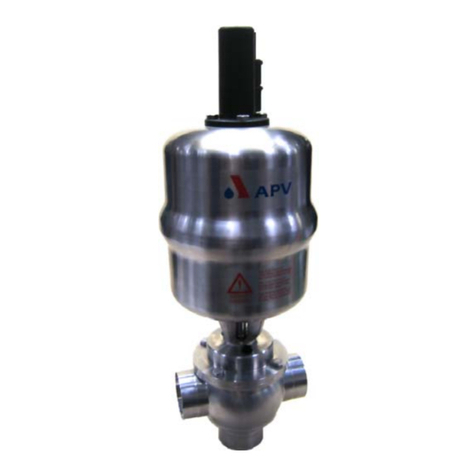
SPX
SPX APV DELTA MS4 User manual
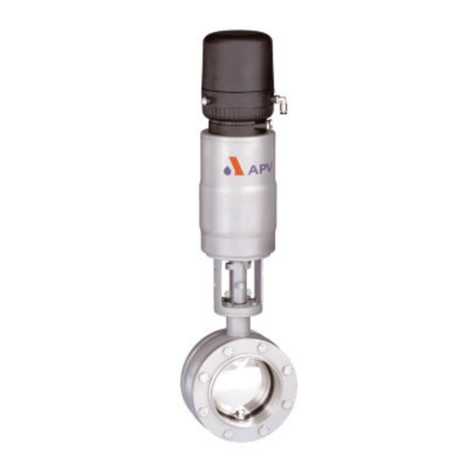
SPX
SPX APV DELTA SVS1F DN 125 User manual

SPX
SPX APV DELTA SV1B User manual
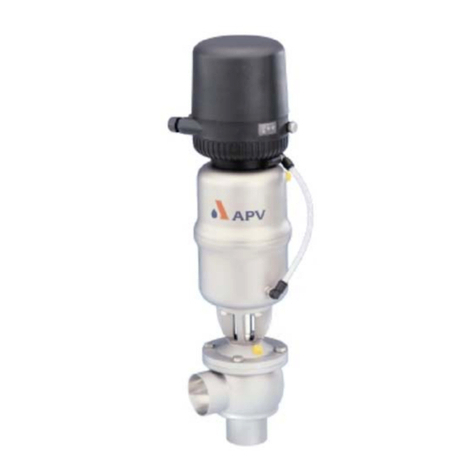
SPX
SPX APV DELTA M4 User manual
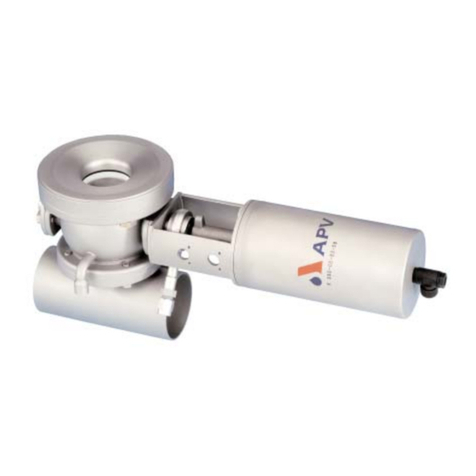
SPX
SPX APV DELTA DKRT2 User manual

SPX
SPX APV DELTA MF4 User manual
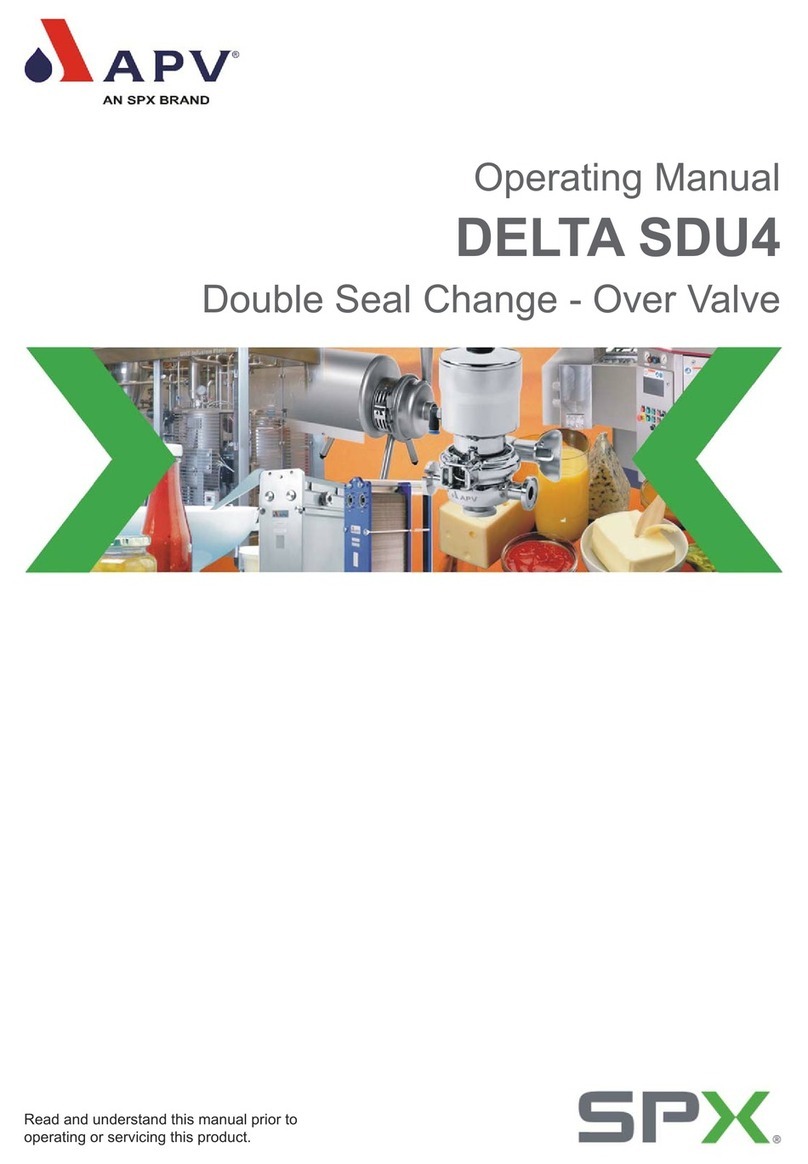
SPX
SPX APV DELTA SDU4 User manual

SPX
SPX Waukesha Cherry-Burrell W Series User manual
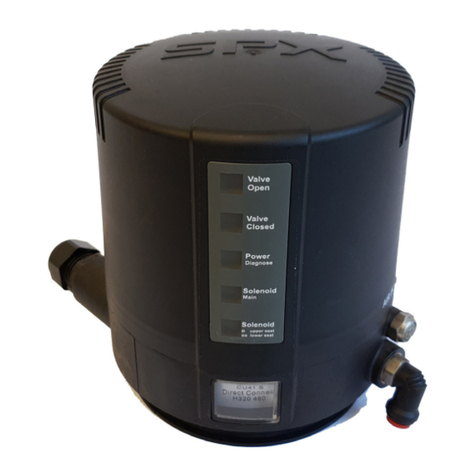
SPX
SPX APV CU4 User manual
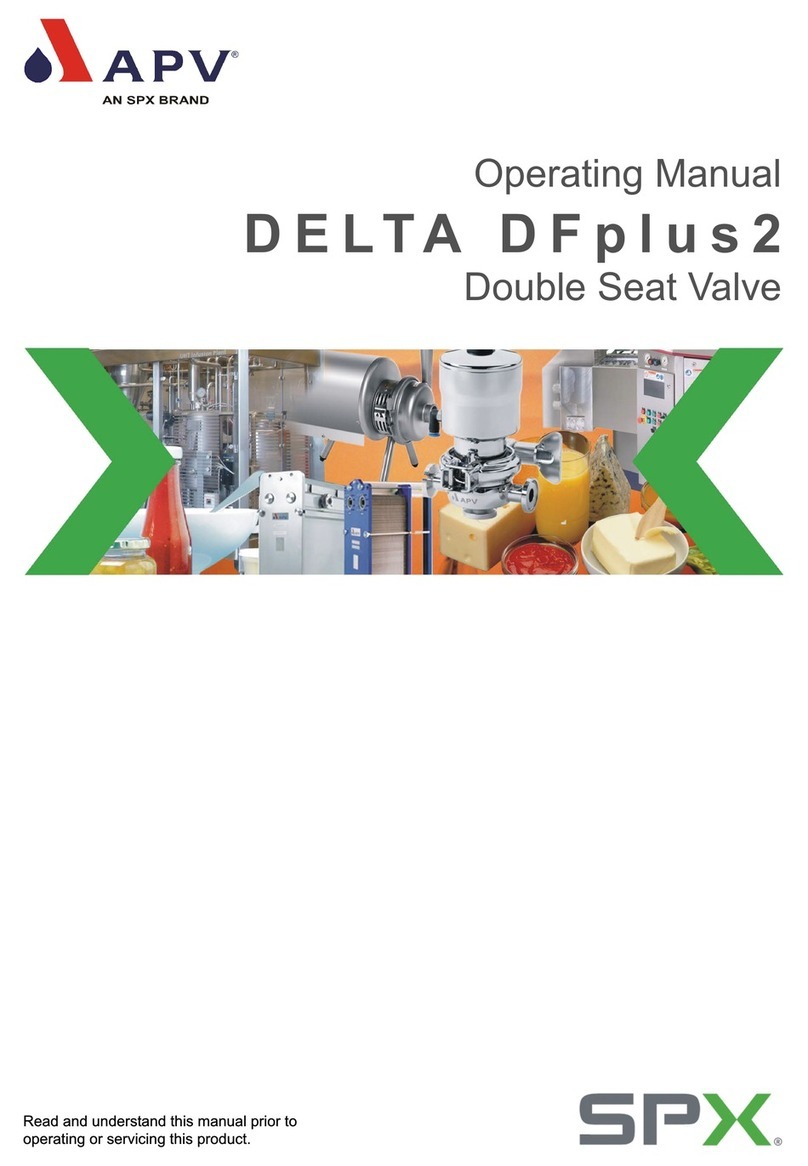
SPX
SPX APV DELTA DF plus 2 User manual



